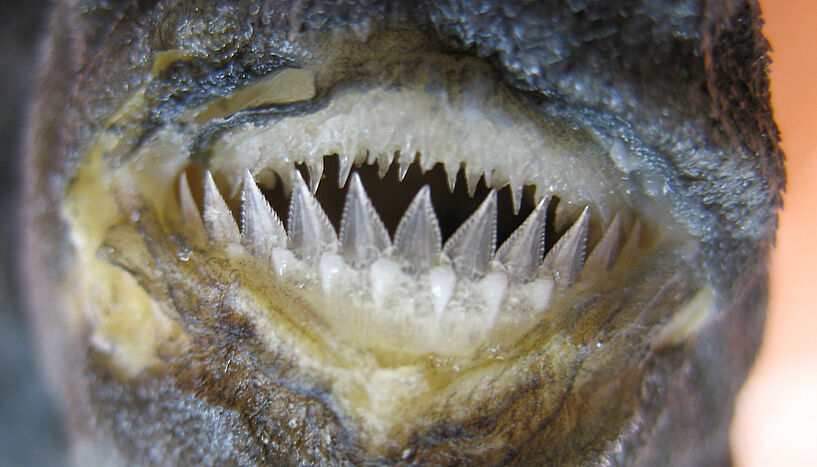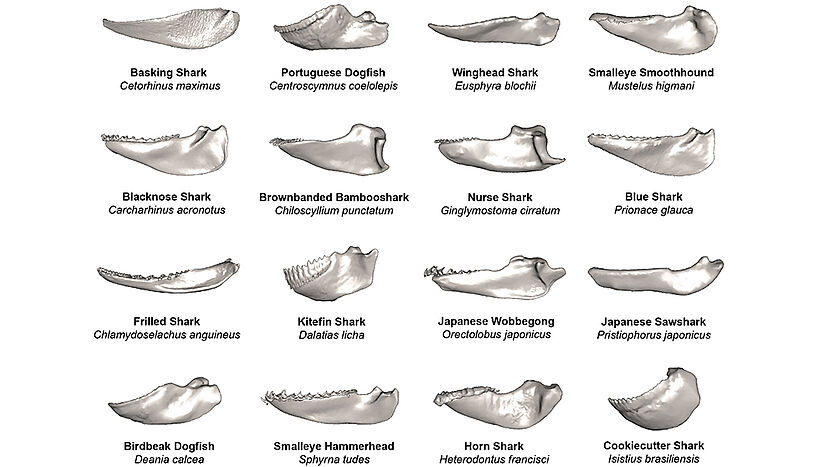Jaw shapes of 90 shark species show: Evolution driven by habitat
16. May 2023Analysis using X-ray computed tomography and 3D reconstructions
An international research team led by Faviel A. López-Romero of the University of Vienna investigated how the jaw shape of sharks has changed over the course of evolution. Their conclusion: in the most widespread shark species, the jaws show relatively little variation in shape over millions of years; most variable jaws were found for deep-sea sharks. The results of this study were published in the journal Communications Biology.
One of the most prominent traits in sharks is the shape of their lower jaws, which bear also impressive teeth. With their jaws, sharks are able to feed on a wide variety of prey, which also places them among the Ocean's top predators. The wide prey spectrum is also reflected in the corresponding adaptations that sharks have evolved through out their evolutionary history. All of these adaptations allow them to spread into virtually all marine habitats, with some species even venturing into freshwater.
How the shape of shark jaws changed during their evolution has now been investigated by an international and multidisciplinary research team, from the University of Vienna, Imperial College London (UK), Muséum national d'histoire naturelle (Paris, France), Christian-Albrechts-University (Kiel, Germany), and Naturalis Museum (Leiden, The Netherlands). The results illustrate the importance of prey, level in the marine webs and habitat in relation to jaw shape diversity among shark species. This also helps to uncover the evolutionary causes of the differences in jaw morphology related to habitats.
Evolutionary history over 180 million years
Today's sharks have a long evolutionary history with some taxa that can be traced as far as 180 million years ago. During all this time they have been a key component in the fauna of the marine realm and its food webs, mainly occupying higher trophic positions as meso and top predators. At the same time, sharks adopted many lifestyles and forms like bottom dwellers, fast swimmers in the open sea, and even some of the smallest species in the deep sea.
To study the potential relationship between jaw morphology and the sharks' life style, a quantitative analysis was conducted using X-ray computed tomographic scans of the jaws of 90 shark species and preparing 3D reconstructions to estimate how jaw shape of sharks evolved through time.
Most variable jaw forms among deep sea sharks
The results indicate surprisingly that among highly species-rich groups such as requiem sharks, the jaws display low shape variations. This is interesting since requiem sharks are one of the most widely distributed group of sharks. Another interesting finding is that most variable jaws were found among species living in the deep sea. "Although sharks from the deep sea are not as extensively represented in the data as reef sharks, they display the most disparate forms seen in our analysis," explains first author Faviel A. López-Romero from the Department of Palaeontology at the University of Vienna.
Among many adaptations, sharks inhabiting the deep sea exhibit, in addition to bioluminescence various feeding strategies that range from taking big chunks out of whales to feeding on eggsor on cephalopods. For most of the species found in reefs and the large top predators in the open sea, the options seem more limited so that most mainly prey on fishes, and even other shark species. "Of course, many sharks in these environments feed on a large variety of prey with only few having adapted to a single, specific prey, such as the bonnethead shark, Sphyrna tiburo, which preys almost entirely on hard-shelled crabs, while shrimps and fish are only capture occasionally," Jürgen Kriwet from the University of Vienna states, who was involved in this study.
Changes through deep time
By studying the evolution of the jaw shape, it also was possible to reconstruct the evolutionary changes in jaw shape through deep time. "Remarkable changes occurred in carpet, sleeper, and dogfish sharks. These changes were probably concomitant with the clear distribution of these sharks in reefs and the deep sea, which noticeably distinguishes them morphologically from other species with larger jaws as seen in the top predators in the open sea,” concludes Faviel A. López-Romero.
Publication in Communications Biology:
Shark mandible evolution reveals patterns of trophic and habitat-mediated diversification. López-Romero, F. A., Stumpf, S., Kamminga, P., Böhmer, C., Pradel, A., Brazeau, M. D., & Kriwet, J. in: Communications Biology (2023)
DOI: 10.1038/s42003-023-04882-3
Figure captions:
Fig. 1: The jaws of Dalatias licha (kitefin shark). The shark's lower teeth form a continuous cutting edge with which it can bite pieces out of larger animals. © Manuel Staggl
Fig. 2: The jaw morphologies of different shark species investigated in the study. © Faviel Alejandro López Romero
Scientific contact
Dr. Faviel Alejandro López Romero
Institut für Paläontologie1090 - Wien, Josef-Holaubek-Platz 2
faviel.alejandro.lopez.romero@univie.ac.at
Further inquiry
Mag. Alexandra Frey
Media Relations ManagerUniversität Wien
1010 - Wien, Universitätsring 1
+43-1-4277-17533
+43-664-8175675
alexandra.frey@univie.ac.at
Downloads:
Lopez_Romero-Jaw_Dalatia_licha-C__Manuel_Staggl.JPG
File size: 1,18 MB
Lopez_Romero-Jaw_shapes-C_Lopez_Romero.jpg
File size: 807,25 KB


